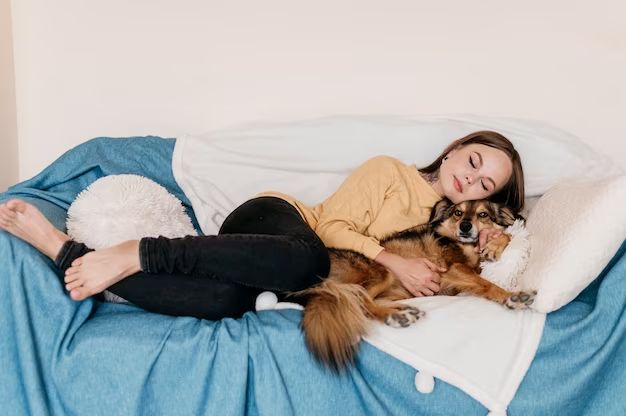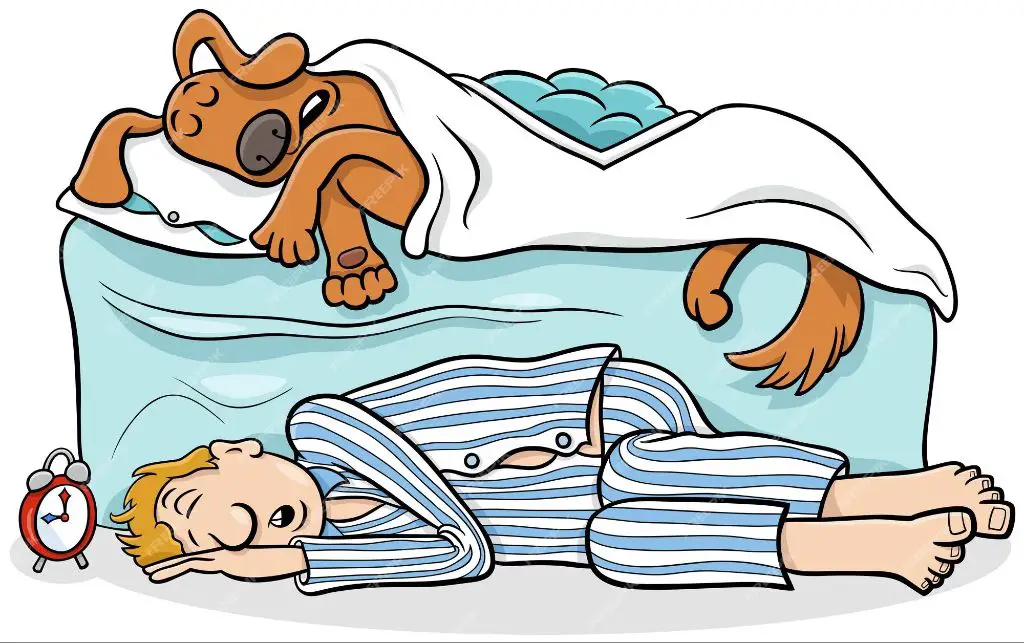Who a Dog Chooses To Sleep With
The behavior of dogs sleeping with humans and other pets can provide fascinating insights into canine social bonds and attachment. Where dogs choose to sleep, especially at night, reveals much about their relationships and perceived pack status.
This article explores why dogs gravitate toward sleeping beside certain people and animals. It examines the potential benefits and drawbacks of allowing your dog to share your bed or sleep near other pets. We’ll also cover tips for ideal sleeping arrangements based on your dog’s age, personality and needs.
Bonding and Attachment
Dogs are intensely social animals that view their human owners as members of their pack. They form strong bonds and attachments to their owners over time, coming to see them as family. Sleeping near their owner allows dogs to feel close to their “pack” and provides them with a sense of belonging, comfort, and security. Just as human family members often like to sleep near each other, dogs enjoy the same closeness and bonding with their owners.
Since dogs are unable to verbalize their feelings of affection, sleeping in the same room or even the same bed is one way they physically express their attachment. It’s a sign of the strength of the relationship and the trust the dog places in that special person. While puppies may initially simply want to be near their caregiver for warmth and protection, adult dogs continue to cherish sleeping beside their owners as it allows them to further strengthen their familial bond.
Providing Comfort
One of the main reasons dogs choose to sleep with owners is because it provides them comfort and security. Dogs are pack animals, so being close to their human companion, especially at night when they’re more vulnerable, gives dogs a sense of reassurance. The presence of their owner helps lower dogs’ stress levels and makes them feel protected. Dogs that sleep in bed with their owners tend to acclimate better in new environments or stressful situations. The physical contact and companionship helps relieve anxiety and prevents separation distress. Sleeping together allows dogs to pick up on their owner’s breathing, movements, and scents during the night. This closeness helps dogs feel at ease and enables a deeper, more restful sleep.
Owner Preference
Some owners enjoy closeness with dogs at night. Sleeping beside a dog can provide comfort and security for the owner. Depending on the owner’s personality, having their pet sleep in bed with them helps them feel less lonely and more content. For people who consider their dog part of the family, co-sleeping reinforces that familial bond.

Additionally, owners may allow their dogs on the bed or in the bedroom simply because that is what the dog prefers. As pack animals, dogs often want to sleep in groups. Letting them sleep on the bed or in the same room allows them to fulfill that instinctual need to be close to their pack at night. An owner may prioritize their dog’s preferences over their own need for space in bed.
Potential Drawbacks
There are some potential problems with letting your dog sleep in the same bed as you. Here are a few things to keep in mind.
Disrupted Sleep
Dogs may disrupt your sleep by moving around frequently, taking up space, or snoring. This can lead to sleep deprivation for you. Some dogs also like to sleep right up against or on top of their owners. This close contact all night long may become uncomfortable.
Lack of Space
Sharing your bed with a dog takes up valuable real estate. Dogs come in all shapes and sizes, but even a small dog can take up a surprising amount of space. This becomes an issue if you share the bed with a partner as well. Three bodies in one bed can feel very crowded.
Sanitary Concerns
Dogs love to play outside, roll in the dirt, and explore new smells. While bathing and grooming helps keep dogs clean, they will inevitably track in dirt, germs, and allergens from outside. These can get into your bedding and cause health issues. There are also concerns about exposure to parasites like fleas when sharing a sleeping space.
Ideal Sleeping Arrangements
When it comes to where your dog sleeps, there are often compromises to be made between the dog’s preferences and the owner’s. Many owners want to have their dogs sleep in bed with them, but don’t want to give up their own comfort and space. Likewise, dogs often prefer to sleep right next to their owners, but may disrupt their owner’s sleep or take up too much room in the bed.

A good compromise is to allow the dog to sleep in the bedroom, but provide them with their own designated sleeping space. Many owners set up a comfortable dog bed on the floor next to the bed, or even at the foot of the bed. This allows the dog to be close to their owner, while still giving the owner most of the bed space. You can also train your dog to start off the night in their own bed, and then allow them to join you later in the night or early morning.
Another option is to have a dog bed in a nearby room, like the living room. This gives your dog their own space, but they are still relatively close by. Just be sure the room is dog-proofed and comfortable. With some training and positive reinforcement, most dogs can learn to happily sleep in their own bed in the same room or nearby room as their owner.
The ideal sleeping arrangement will vary based on your own preferences and comfort, as well as your dog’s needs and behavior. But compromising by providing your dog a comfortable bed space near you can help satisfy both parties.
Puppy Sleep Training
Getting puppies used to sleeping in proper areas from a young age will pay off down the road. Puppies should sleep in crates or designated puppy areas, not in bed with people. This teaches them independence and prevents separation anxiety. Start crate training as soon as you bring a new puppy home. Place the crate in your bedroom initially so the puppy feels comforted having you nearby. Slowly move the crate to the desired sleeping area over time.

Set up consistent routines for taking your puppy outside to relieve themselves during the night. Praise and reward them for going potty in the right spot. Clean up any accidents calmly without scolding. Limit access to your bedroom and furniture until your puppy is fully housetrained. Provide lots of chew toys in the crate and nearby to occupy them. Be patient – puppies can take months to reliably sleep through the night and transition to new sleeping arrangements.
Senior Dogs
As dogs age, their sleeping habits and needs often change. Senior dogs tend to sleep more due to decreased energy levels and may need more frequent daytime napping. Their sleep quality also tends to decline as they develop arthritis, muscle weakness, and other age-related issues that can make getting comfortable difficult.
There are several things you can do to help accommodate an elderly dog’s needs when it comes to sleep:
- Provide thick, orthopedic bedding to cushion their joints and help them get comfortable.
- Allow them to sleep in a warmer area of the house if they have difficulty regulating their body temperature.
- Consider using ramps, stairs, or lifting them onto furniture if they have mobility issues.
- Take more frequent potty breaks overnight to accommodate declining bladder control.
- Check with your vet about medications or supplements that could help with pain, anxiety, or other issues disrupting their sleep.
- Stick to a consistent routine and schedule.
Making some simple adjustments can go a long way in ensuring your senior dog continues to get the deep, restorative sleep they need. Pay attention to any changes in their sleep patterns or behavior and discuss any concerns with your veterinarian.

Conclusion
In summary, dogs often choose to sleep with their owners or certain family members as a sign of bonding, comfort, and attachment. While cute, co-sleeping with dogs does come with some potential drawbacks like disrupted sleep or inappropriate pet behavior. Owners should aim to set up ideal sleeping arrangements for dogs that allow for closeness and bonding while also promoting healthy sleep habits, independence, and proper manners. With some effort, pet parents can train both puppies and senior dogs to happily sleep in designated dog beds or rooms without disrupting human sleep or suffering from separation anxiety. The takeaway is that who a dog chooses to sleep with provides insight into the dog’s preferences and relationships. However, owners must also consider their own needs and set appropriate boundaries around co-sleeping.
References
Paul, L. (2019). Where Do Dogs Like to Sleep: All You Need to Know. American Kennel Club. https://www.akc.org/expert-advice/lifestyle/where-do-dogs-like-to-sleep/
Coren, S. (2014). Does Allowing Your Dog to Sleep with You Decrease His Anxiety? Psychology Today. https://www.psychologytoday.com/us/blog/canine-corner/201404/does-allowing-your-dog-sleep-in-your-bed-decrease-his-anxiety
Miklósi, Á. (2014). Dog behaviour, evolution, and cognition. Oxford University Press.
Bradshaw, J.W. (2011). Dog Sense: How the New Science of Dog Behavior Can Make You a Better Friend to Your Pet. Basic Books.